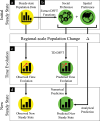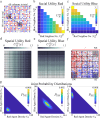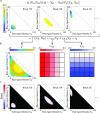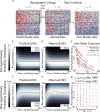Small-area population forecasting in a segregated city using density-functional fluctuation theory
- PMID: 39524064
- PMCID: PMC11541354
- DOI: 10.1007/s42001-024-00305-3
Small-area population forecasting in a segregated city using density-functional fluctuation theory
Abstract
Policy decisions concerning housing, transportation, and resource allocation would all benefit from accurate small-area population forecasts. However, despite the success of regional-scale migration models, developing neighborhood-scale forecasts remains a challenge due to the complex nature of residential choice. Here, we introduce an innovative approach to this challenge by extending density-functional fluctuation theory (DFFT), a proven approach for modeling group spatial behavior in biological systems, to predict small-area population shifts over time. The DFFT method uses observed fluctuations in small-area populations to disentangle and extract effective social and spatial drivers of segregation, and then uses this information to forecast intra-regional migration. To demonstrate the efficacy of our approach in a controlled setting, we consider a simulated city constructed from a Schelling-type model. Our findings indicate that even without direct access to the underlying agent preferences, DFFT accurately predicts how broader demographic changes at the city scale percolate to small-area populations. In particular, our results demonstrate the ability of DFFT to incorporate the impacts of segregation into small-area population forecasting using interactions inferred solely from steady-state population count data.
Keywords: Density-functional fluctuation theory; Migration; Residential choice; Schelling model; Segregation; Small-area forecasts.
© The Author(s) 2024.
Conflict of interest statement
Conflict of interestOn behalf of all authors, the corresponding author states that there is no conflict of interest.
Figures





Similar articles
-
The co-evolution of residential segregation and the built environment at the turn of the 20th century: a Schelling model.Trans GIS. 2014 Feb;18(1):25-45. doi: 10.1111/tgis.12014. Trans GIS. 2014. PMID: 25419167 Free PMC article.
-
Methods for Small Area Population Forecasts: State-of-the-Art and Research Needs.Popul Res Policy Rev. 2022;41(3):865-898. doi: 10.1007/s11113-021-09671-6. Epub 2021 Aug 16. Popul Res Policy Rev. 2022. PMID: 34421158 Free PMC article.
-
Residential preferences and neighborhood racial segregation: a test of the Schelling segregation model.Demography. 1991 Feb;28(1):1-19. Demography. 1991. PMID: 2015937
-
Incorporating local adaptation into forecasts of species' distribution and abundance under climate change.Glob Chang Biol. 2019 Mar;25(3):775-793. doi: 10.1111/gcb.14562. Epub 2019 Jan 24. Glob Chang Biol. 2019. PMID: 30597712 Review.
-
Decadal-Scale Forecasting of Climate Drivers for Marine Applications.Adv Mar Biol. 2016;74:1-68. doi: 10.1016/bs.amb.2016.04.002. Epub 2016 Jun 17. Adv Mar Biol. 2016. PMID: 27573049 Review.
Cited by
-
Analyzing NBA player positions and interactions with density-functional fluctuation theory.Sci Rep. 2025 Jun 5;15(1):19830. doi: 10.1038/s41598-025-04953-x. Sci Rep. 2025. PMID: 40473740 Free PMC article.
References
-
- Anderson, L. M., Charles, J. S., Fullilove, M. T., et al. (2003). Providing affordable family housing and reducing residential segregation by income: A systematic review. American Journal of Preventive Medicine,24(3), 47–67. - PubMed
-
- Barron, B., Kinkhabwala, Y.A., Hess, C., et al (2022) Extending the use of information theory in segregation analyses to construct comprehensive models of segregation. arXiv preprint arXiv:2212.06980
-
- Benenson, I., Hatna, E., & Or, E. (2009). From schelling to spatially explicit modeling of urban ethnic and economic residential dynamics. Sociological Methods & Research,37(4), 463–497.
-
- Bruch, E. E., & Mare, R. D. (2006). Neighborhood choice and neighborhood change. American Journal of Sociology,112(3), 667–709.
LinkOut - more resources
Full Text Sources
